consistent hashing ΩéóÊ≥ïÊó©Âú® 1997 Úq¥Â∞±Âú®ËÆ∫Êñ?/span> Consistent hashing and random trees ‰∏≠Ë¢´ÊèêÂá∫ÂQåÁõÆÂâçÂú® cache æp»ùªü‰∏≠Â∫îÁî®Ë∂äÊù•Ë∂äÚqøÊ≥õÂQ?/span>
1 基本场景
ÊØî¶ljΩÝÊúâ N ‰∏?/span> cache ÊúçÂä°Âô®ÔºàÂêéÈù¢ΩéÄøU?/span> cache ÂQâÔºåÈÇ£‰πà¶ljΩïûÆ܉∏ĉ∏™ÂØπ˱?/span> object ÊòÝÂ∞ÑÂà?/span> N ‰∏?/span> cache ‰∏äÂë¢ÂQå‰ΩÝÂæàÂèØËÉΩ‰ºö(x®¨)ÈááÁî®æc÷Mºº‰∏ãÈù¢ÁöÑÈÄöÁî®Êñ“é(gu®©)≥ïËÆ°ÁÆó object Áö?/span> hash ÂÄ˚|ºåÁÑ∂ÂêéÂùáÂåÄÁöÑÊòÝûÆÑÂà∞Âà?/span> N ‰∏?/span> cache ÂQ?/span>
hash(object)%N
‰∏ÄÂàáÈÉΩòqêË°åÊ≠£Â∏∏ÂQåÂÜçËÄÉËôë¶lj∏ãÁöщ∏§øUçÊÉÖÂܵԺõ
1 ‰∏ĉ∏?/span> cache ÊúçÂä°Âô?/span> m down Êéâ‰∫Ü(ji®£n)ÂQàÂú®ÂÆûÈôÖÂ∫îÁ∏≠ÂøÖôª˶ÅËÄÉËôëòqôÁßçÊÉÖÂܵÂQâÔºåòqôÊÝ∑ÊâÄÊúâÊòÝûÆÑÂà∞ cache m ÁöÑÂØπ˱°ÈÉΩ‰º?x®¨)§±ÊïàÔºåÊÄé‰πàÂäûÔºåÈúÄ˶ÅÊää cache m ‰ª?/span> cache ‰∏≠ÁߪÈô§ÔºåòqôÊó∂ÂÄ?/span> cache Êò?/span> N-1 ÂèéÕºåÊòÝÂ∞ÑÂ֨ºèÂèòÊàê‰∫?/span> hash(object)%(N-1) ÂQ?/span>
2 Áî◊É∫éËÆâKóÆÂäÝÈáçÂQåÈúÄ˶ÅÊ∑ªÂä?/span> cache ÂQåËøôÊó∂ÂÄ?/span> cache Êò?/span> N+1 ÂèéÕºåÊòÝÂ∞ÑÂ֨ºèÂèòÊàê‰∫?/span> hash(object)%(N+1) ÂQ?/span>
1 Âí?/span> 2 ÊÑèÂë≥ÁùĉªÄ‰πàÔºüòqôÊÑèÂë≥ÁùÄΩHÅÁÑ∂‰πãÈó¥Âá݉πéÊâÄÊúâÁöÑ cache ÈÉΩ§±Êïà‰∫Ü(ji®£n)„ÄÇÂØπ‰∫éÊúçÂä°Âô®ËÄåË®ÄÂQåËøôÊò؉∏ÄÂú∫ÁÅæÈöæÔºåãz™Ê∞¥Ëà¨ÁöÑËÆâKóÆÈÉΩ‰ºö(x®¨)Áõ¥Êé•ÂÜ≤ÂêëÂêéÂè∞ÊúçÂä°Âô®Ôºõ
ÂÜçÊù•ËÄÉËôëΩW¨‰∏â‰∏™ÈóÆÈ¢òÔºåÁî◊É∫éºã¨‰ögËÉΩÂäõ≠ëäÊù•≠ëäº∫ÂQå‰ΩÝÂèØËÉΩÊÉåôÆ©ÂêéÈù¢Ê∑’däÝÁöÑËäÇÁÇπ§öÂÅöÁÇπãzªÔºåÊòÑ°Ñ∂‰∏äÈù¢Áö?/span> hash ΩéóÊ≥ï‰πüÂÅö‰∏çÂà∞„Ä?/span>
Êú≪ĉπàÊñπÊ≥ïÂè؉ª•ÊîπÂèòËøô‰∏™Áä∂ÂܵÂë¢ÂQåËøôûƱÊòØ consistent hashing...
2 hash ΩéóÊ≥ïÂíåÂçïË∞ÉÊÄ?/h2>
„ÄÄ„ÄÄ Hash ΩéóÊ≥ïÁöщ∏ĉ∏™Ë°°ÈáèÊåáÊÝáÊòØÂçïË∞ÉÊÄßÔºà Monotonicity ÂQâÔºåÂÆö‰πâ¶lj∏ãÂQ?/span>
„ÄÄ„ÄÄÂçïË∞ÉÊÄßÊòØÊåá¶ÇÊûúÂ∑≤ælèÊúâ‰∏ĉ∫õÂÜÖÂÆöwÄöËøáÂìàÂ∏åÂàÜÊ¥æÂàÓC∫Ü(ji®£n)Áõ∏Â∫îÁöÑÁºìÂÜ≤‰∏≠ÂQåÂèàÊúâÊñ∞ÁöÑÁºìÂÜ≤ÂäÝÂÖ•Âà∞æp»ùªü‰∏≠„ÄÇÂìàÂ∏åÁöÑælìÊûúÂ∫îËÉΩ§ü‰øùËØÅÂéüÊúâÂ∑≤ÂàÜÈÖçÁöÑÂÜÖÂÆπÂè؉ª•Ë¢´ÊòÝÂ∞ÑÂà∞Êñ∞ÁöÑÁºìÂÜ≤‰∏≠ÂéªÔºåËÄå‰∏牺?x®¨)Ë¢´ÊòÝÂ∞ÑÂà∞ÊóßÁöÑÁºìÂÜ≤ÈõÜÂêà‰∏≠ÁöÑÂÖ∂‰ªñÁºìÂÜ≤Âå∫„Ä?/span>
ÂÆ“é(gu®©)òìÁúãÂà∞ÂQå‰∏äÈù¢ÁöÑΩéÄÂç?/span> hash ΩéóÊ≥ï hash(object)%N Èö扪•Êª°ËɈÂçïË∞ÉÊÄß˶ÅʱDŽÄ?/span>
3 consistent hashing ΩéóÊ≥ïÁöÑÂéüÁê?/h2>
consistent hashing Êò؉∏ÄøU?/span> hash ΩéóÊ≥ïÂQåÁÆÄÂçïÁöÑËØþ_(d®¢)ºåÂú®ÁߪÈô?/span> / Ê∑’dä݉∏ĉ∏?/span> cache Êó”ûºåÂÆÉËÉΩ§üÂ∞ΩÂèØËÉΩûÆèÁöÑÊîπÂèòÂ∑≤Â≠òÂú?/span> key ÊòÝÂ∞ÑÂÖ≥Á≥ªÂQåÂ∞ΩÂèØËÉΩÁöÑʪ°≠ëõ_çïË∞ÉÊÄßÁöÑ˶ÅʱDŽÄ?/span>
‰∏ãÈù¢ûƱÊù•ÊåâÁÖß 5 ‰∏™Ê≠•È™§ÁÆÄÂçïËÆ≤ËÆ?/span> consistent hashing ΩéóÊ≥ïÁöÑÂü∫Êú¨ÂéüÁêÜ„Ä?/span>
3.1 ÁéØÂ≈ûhash ΩI∫Èó¥
ËÄÉËôëÈÄöÂ∏∏Áö?/span> hash ΩéóÊ≥ïÈÉΩÊòØûÆ?/span> value ÊòÝÂ∞ÑÂàÓC∏ĉ∏?/span> 32 ‰∏∫ÁöÑ key ÂÄ˚|ºå‰πüÂç≥Êò?/span> 0~2^32-1 ã∆°ÊñπÁöÑÊï∞ÂĺÁ©∫Èóþ_(d®¢)ºõÊà뉪¨Âè؉ª•ûÆÜËøô‰∏™Á©∫Èó¥ÊÉ≥˱°Êàê‰∏ĉ∏™È¶ñÂQ?/span> 0 ÂQâÂ∞æÂQ?/span> 2^32-1 ÂQâÁõ∏Êé•ÁöÑÂúÜÁéØÂQå¶lj∏ãÈù¢Âõ?/span> 1 ÊâÄΩC∫ÁöÑÈÇ£ÊÝ∑„Ä?/span>
Âõ?/span> 1 ÁéØÂ≈û hash ΩI∫Èó¥
3.2 ÊääÂØπ˱°ÊòÝûÆÑÂà∞hash ΩI∫Èó¥
Ê镉∏ãÊù•ËÄÉËôë 4 ‰∏™ÂØπ˱?/span> object1~object4 ÂQåÈÄöËøá hash ÂáΩÊï∞ËÆ°ÁÆóÂá∫ÁöÑ hash ÂÄ?/span> key Âú®Áé؉∏äÁöÑÂàÜÂ∏ɶÇÂõæ 2 ÊâÄΩC∫„Ä?/span>
hash(object1) = key1;
… …
hash(object4) = key4;
Âõ?/span> 2 4 ‰∏™ÂØπ˱°ÁöÑ key ÂĺÂàÜÂ∏?/span>
3.3 Êääcache ÊòÝÂ∞ÑÂà∞hash ΩI∫Èó¥
Consistent hashing ÁöÑÂü∫Êú¨ÊÄùÊÉ≥ûƱÊòØûÆÜÂØπ˱°Âíå cache ÈÉΩÊòÝûÆÑÂà∞Âêå‰∏ĉ∏?/span> hash Êï∞ÂĺÁ©∫Èó¥‰∏≠ÂQåÂ∆à‰∏î‰ã…Áî®Áõ∏ÂêåÁöÑhash ΩéóÊ≥ï„Ä?/span>
ÂÅáËÆæÂΩìÂâçÊú?/span> A,B Âí?/span> C ÂÖ?/span> 3 Âè?/span> cache ÂQåÈÇ£‰πàÂÖ∂ÊòÝÂ∞ÑælìÊûúûÆܶÇÂõ?/span> 3 ÊâÄΩC∫Ժ剪ñ‰ª¨Âú?/span> hash ΩI∫Èó¥‰∏≠Ժ剪•ÂØπÂ∫îÁöÑ hashÂĺÊéíÂàó„Ä?/span>
hash(cache A) = key A;
… …
hash(cache C) = key C;
Âõ?/span> 3 cache ÂíåÂØπ˱°ÁöÑ key ÂĺÂàÜÂ∏?/span>
ËØ¥Âà∞òqôÈáåÂQåÈ°∫‰æøÊèê‰∏ĉ∏?/span> cache Áö?/span> hash ËÆ°ÁÆóÂQå‰∏ÄËà¨ÁöÑÊñ“é(gu®©)≥ïÂè؉ª•‰ΩøÁî® cache Êú∫Âô®Áö?/span> IP Âú∞ÂùÄÊàñËÄÖÊú∫Âô®Âêç‰Ωú‰ÿì(f®¥)hash ËæìÂÖ•„Ä?/span>
3.4 ÊääÂØπ˱°ÊòÝûÆÑÂà∞cache
Áé∞Âú® cache ÂíåÂØπ˱°ÈÉΩÂ∑≤ÁªèÈÄöËøáÂêå‰∏ĉ∏?/span> hash ΩéóÊ≥ïÊòÝÂ∞ÑÂà?/span> hash Êï∞ÂĺÁ©∫Èó¥‰∏≠‰∫?ji®£n)ÔºåÊ镉∏ãÊù•Ë¶ÅËÄÉËôëÁöÑÂ∞±ÊòضljΩïÂ∞ÜÂØπ˱°ÊòÝÂ∞ÑÂà?/span> cache ‰∏äÈù¢‰∫?ji®£n)„Ä?/span>
Âú®Ëøô‰∏™ÁéØÂΩ¢Á©∫Èó¥‰∏≠ÂQå¶ÇÊûúÊ≤øÁùÄôÂ∫Êó∂ÈíàÊñπÂê뉪éÂØπ˱°Áö?/span> key ÂĺÂá∫ÂèëÔºåÁõ¥Âà∞ÈÅáËßʼn∏ĉ∏?/span> cache ÂQåÈÇ£‰πàÂ∞±ûÆÜËØ•ÂØπ˱°Â≠òÂÇ®Âú®Ëøô‰∏?/span> cache ‰∏äÔºåÂõ݉ÿì(f®¥)ÂØπ˱°Âí?/span> cache Áö?/span> hash ÂĺÊòØÂõ∫ÂÆöÁöÑÔºåÂõÝÊ≠§òqô‰∏™ cache ÂøÖÁÑ∂ÊòØÂî؉∏ÄÂíåÁ°ÆÂÆöÁöÑ„ÄÇËøôÊÝ∑‰∏çûƱÊâæÂàÓC∫Ü(ji®£n)ÂØπ˱°Âí?/span> cache ÁöÑÊòÝûÆÑÊñπÊ≥ï‰∫Ü(ji®£n)ÂêóÔºüÂQ?/span>
‰æùÁÑ∂ælßÁÆã(hu®§)‰∏äÈù¢ÁöщæãÂ≠êÔºàÂèÇËßÅÂõ?/span> 3 ÂQâÔºåÈÇ£‰πàÊÝ“é(gu®©)çƉ∏äÈù¢ÁöÑÊñπÊ≥ïÔºåÂØπ˱° object1 ûÆÜË¢´Â≠òÂÇ®Âà?/span> cache A ‰∏äÔºõ object2Âí?/span> object3 ÂØπÂ∫îÂà?/span> cache C ÂQ?/span> object4 ÂØπÂ∫îÂà?/span> cache B ÂQ?/span>
3.5 ËÄÉÂØücache ÁöÑÂèòÂä?/h3>
ÂâçÈù¢ËÆ≤ËøáÂQåÈÄöËøá hash ÁÑ∂ÂêéʱljΩôÁöÑÊñπÊ≥ïÂ∏¶Êù•ÁöÑÊúħßÈóÆÈ¢òÂ∞±Âú®‰∫é‰∏çËÉΩʪ°ËɈÂçïË∞ÉÊÄßÔºåÂΩ?/span> cache ÊúâÊâÄÂèòÂä®Êó”ûºåcache ‰º?x®¨)§±ÊïàÔºåòqõËÄåÂØπÂêéÂè∞ÊúçÂä°Âô®ÈÄÝÊàêÂ∑®Â§ßÁöÑÂÜ≤ÂáªÔºåÁé∞Âú®ûƱÊù•ÂàÜÊûêÂàÜÊûê consistent hashing ΩéóÊ≥ï„Ä?/span>
3.5.1 øUªÈô§ cache
ËÄÉËôëÂÅáËÆæ cache B ÊåÇÊéâ‰∫?ji®£n)ÔºåÊÝ“?gu®©)çƉ∏äÈù¢ËÆ≤Âà∞ÁöÑÊòÝûÆÑÊñπÊ≥ïÔºåòqôÊó∂Âèó™Ñ(ji®£ng)ÂìçÁöÑûÆ܉ªÖÊòØÈÇ£‰∫õÊ≤ø cache B ÈÄÜÊó∂ÈíàÈÅçÂéÜÁõ¥ÂàÓC∏ã‰∏ĉ∏?/span> cache ÂQ?/span> cache C ÂQâ‰πãÈó¥ÁöÑÂØπ˱°ÂQå‰πüÂçœx(ch®Æng)òØÊú¨Êù•ÊòÝÂ∞ÑÂà?/span> cache B ‰∏äÁöÑÈÇ£‰∫õÂØπ˱°„Ä?/span>
ÂõÝÊ≠§òqôÈá剪ÖÈúÄ˶ÅÂèòÂä®ÂØπ˱?/span> object4 ÂQåÂ∞ÜÂÖâôáçÊñ∞ÊòÝûÆÑÂà∞ cache C ‰∏äÂç≥ÂèØÔºõÂèÇËßÅÂõ?/span> 4 „Ä?/span>
Âõ?/span> 4 Cache B Ë¢´ÁߪÈô§ÂêéÁö?/span> cache ÊòÝÂ∞Ñ
3.5.2 Ê∑’däÝ cache
ÂÜçËÄÉËôëÊ∑’dä݉∏ÄÂè∞Êñ∞Áö?/span> cache D ÁöÑÊÉÖÂܵԺåÂÅáËÆæÂú®Ëøô‰∏™ÁéØÂΩ?/span> hash ΩI∫Èó¥‰∏≠Ôºå cache D Ë¢´ÊòÝûÆÑÂú®ÂØπ˱° object2 Âí?/span>object3 ‰πãÈó¥„ÄÇËøôÊó∂ÂèóÂΩ±ÂìçÁöÑÂ∞܉ªÖÊòØÈÇ£‰∫õÊ≤?/span> cache D ÈÄÜÊó∂ÈíàÈÅçÂéÜÁõ¥ÂàÓC∏ã‰∏ĉ∏?/span> cache ÂQ?/span> cache B ÂQâ‰πãÈó¥ÁöÑÂØπ˱°ÂQàÂÆɉª¨Êò؉πüÊú¨Êù•ÊòÝûÆÑÂà∞ cache C ‰∏äÂØπ˱°Áöщ∏ÄÈÉ®ÂàÜÂQâÔºåûÆÜËøô‰∫õÂØπ˱°ÈáçÊñ∞ÊòÝûÆÑÂà∞ cache D ‰∏äÂç≥ÂèØ„Ä?/span>
ÂõÝÊ≠§òqôÈá剪ÖÈúÄ˶ÅÂèòÂä®ÂØπ˱?/span> object2 ÂQåÂ∞ÜÂÖâôáçÊñ∞ÊòÝûÆÑÂà∞ cache D ‰∏äÔºõÂèÇËßÅÂõ?/span> 5 „Ä?/span>
Âõ?/span> 5 Ê∑’däÝ cache D ÂêéÁöÑÊòÝÂ∞ÑÂÖ≥Á≥ª
4 虚拟节点
ËÄÉÈáè Hash ΩéóÊ≥ïÁöÑÂ趉∏ĉ∏™ÊåáÊÝáÊòØÚqåô°°ÊÄ?/span> (Balance) ÂQåÂÆö‰πâ¶lj∏ãÔºö(x®¨)
Úqåô°°ÊÄ?/span>
„ÄÄ„ÄÄÚqåô°°ÊÄßÊòØÊåáÂìàÂ∏åÁöÑælìÊûúËÉΩ§üûÆΩÂèØËÉΩÂàÜÂ∏ÉÂà∞ÊâÄÊúâÁöÑæ~ìÂÜ≤‰∏≠ÂéªÂQåËøôÊÝ∑Âè؉ª•‰ã…ÂæóÊâÄÊúâÁöÑæ~ìÂÜ≤ΩI∫Èó¥ÈÉΩÂæóÂà∞Âà©ÁÄ?/span>
hash ΩéóÊ≥ïÚq∂‰∏çÊò؉øùËØÅÁªùÂØπÁöÑÚqåô°°ÂQå¶ÇÊû?/span> cache ËæÉÂ∞ëÁöÑËØùÂQåÂØπ˱°Â∆à‰∏çËÉΩË¢´ÂùáÂåÄÁöÑÊòÝûÆÑÂà∞ cache ‰∏äÔºåÊØî¶ÇÂú®‰∏äÈù¢ÁöщæãÂ≠ê‰∏≠Ժ剪ÖÈÉ®æ|?/span> cache A Âí?/span> cache C ÁöÑÊÉÖÂܵ‰∏ãÂQåÂú® 4 ‰∏™ÂØπ˱°‰∏≠ÂQ?/span> cache A ‰ªÖÂ≠òÂÇ®‰∫Ü(ji®£n) object1 ÂQåËÄ?/span> cache C ÂàôÂ≠òÂÇ®‰∫Ü(ji®£n) object2 „Ä?/span> object3 Âí?/span> object4 ÂQõÂàÜÂ∏ÉÊòØÂæà‰∏çÂùáË°°ÁöÑ„Ä?/span>
‰∏ÞZ∫Ü(ji®£n)ËߣÂÜ≥òqôÁßçÊÉÖÂܵÂQ?/span> consistent hashing ºïÂÖ•‰∫?#8220;ËôöÊãüËäÇÁÇπ”ÁöÑʶÇÂøµÔºåÂÆÉÂè؉ª•Â¶Ç‰∏ãÂÆö‰πâÔºö(x®¨)
“ËôöÊãüËäÇÁÇπ”ÂQ?/span> virtual node ÂQâÊòØÂÆûÈôÖËäÇÁÇπÂú?/span> hash ΩI∫Èó¥ÁöѧçÂà∂ÂìÅÂQ?/span> replica ÂQâÔºå‰∏ÄÂÆûÈôÖ‰∏™ËäÇÁÇπÂØπÂ∫î‰∫Ü(ji®£n)Ëã•Âπ≤‰∏?#8220;ËôöÊãüËäÇÁÇπ”ÂQåËøô‰∏™ÂØπÂ∫î‰∏™ÊïÓCπüÊàê‰ÿì(f®¥)“§çÂà∂‰∏™Êï∞”ÂQ?#8220;ËôöÊãüËäÇÁÇπ”Âú?/span> hash ΩI∫Èó¥‰∏≠‰ª• hash ÂĺÊéíÂàó„Ä?/span>
‰ªç‰ª•‰ªÖÈÉ®æ|?/span> cache A Âí?/span> cache C ÁöÑÊÉÖÂܵ‰ÿì(f®¥)‰æãÔºåÂú®Âõæ 4 ‰∏≠Êà뉪¨Â∑≤ælèÁúãÂàéÕºå cache ÂàÜÂ∏ÉÚq∂‰∏çÂùáÂåÄ„ÄÇÁé∞Âú®Êà뉪¨ÂºïÂÖ•ËôöÊãüËäÇÁÇπÔºåÚq∂ËÆææ|?#8220;§çÂà∂‰∏™Êï∞”‰∏?/span> 2 ÂQåËøôûƱÊÑèÂë≥Áùĉ∏ÄÂÖ◊ɺö(x®¨)Â≠òÂú® 4 ‰∏?#8220;ËôöÊãüËäÇÁÇπ”ÂQ?/span> cache A1, cache A2 ‰ª£Ë°®‰∫?/span> cache A ÂQ?/span> cache C1, cache C2 ‰ª£Ë°®‰∫?/span> cache C ÂQõÂÅáËÆæ‰∏ÄøUçÊØîËæÉÁêÜÊÉ≥ÁöÑÊÉÖÂܵÂQåÂèÇËßÅÂõæ 6 „Ä?/span>
Âõ?/span> 6 ºïÂÖ•“ËôöÊãüËäÇÁÇπ”ÂêéÁöÑÊòÝÂ∞ÑÂÖ≥Á≥ª
Ê≠§Êó∂ÂQåÂØπ˱°Âà∞“ËôöÊãüËäÇÁÇπ”ÁöÑÊòÝûÆÑÂÖ≥æp÷Mÿì(f®¥)ÂQ?/span>
objec1->cache A2 ÂQ?/span> objec2->cache A1 ÂQ?/span> objec3->cache C1 ÂQ?/span> objec4->cache C2 ÂQ?/span>
ÂõÝÊ≠§ÂØπ˱° object1 Âí?/span> object2 ÈÉΩË¢´ÊòÝÂ∞ÑÂàÓC∫Ü(ji®£n) cache A ‰∏äÔºåËÄ?/span> object3 Âí?/span> object4 ÊòÝÂ∞ÑÂàÓC∫Ü(ji®£n) cache C ‰∏äÔºõÚqåô°°ÊÄßÊúâ‰∫?ji®£n)Âæà§ßÊèêÈ´ò„Ä?/span>
ºïÂÖ•“ËôöÊãüËäÇÁÇπ”ÂêéÔºåÊòÝÂ∞ÑÂÖ≥Á≥ªûÆ◊ɪé { ÂØπ˱° -> ËäÇÁÇπ } ËΩ¨Êç¢ÂàÓC∫Ü(ji®£n) { ÂØπ˱° -> ËôöÊãüËäÇÁÇπ } „ÄÇÊü•ËØ¢Á⩉ΩìÊâÄÂú?/span> cacheÊó∂ÁöÑÊòÝÂ∞ÑÂÖ≥Á≥ªÂ¶ÇÂõæ 7 ÊâÄΩC∫„Ä?/span>
Âõ?/span> 7 Êü•ËØ¢ÂØπ˱°ÊâÄÂú?/span> cache
“ËôöÊãüËäÇÁÇπ”Áö?/span> hash ËÆ°ÁÆóÂè؉ª•ÈááÁî®ÂØπÂ∫îËäÇÁÇπÁö?/span> IP Âú∞ÂùÄÂäÝÊï∞Â≠óÂêéæ~ÄÁöÑÊñπºè„Äljæã¶ÇÂÅáËÆ?/span> cache A Áö?/span> IP Âú∞Âùĉ∏?/span>202.168.14.241 „Ä?/span>
ºïÂÖ•“ËôöÊãüËäÇÁÇπ”ÂâçÔºåËÆ°ÁÆó cache A Áö?/span> hash ÂÄ˚|ºö(x®¨)
Hash(“202.168.14.241”);
ºïÂÖ•“ËôöÊãüËäÇÁÇπ”ÂêéÔºåËÆ°ÁÆó“ËôöÊãüËä?#8221;ÁÇ?/span> cache A1 Âí?/span> cache A2 Áö?/span> hash ÂÄ˚|ºö(x®¨)
Hash(“202.168.14.241#1”); // cache A1
Hash(“202.168.14.241#2”); // cache A2
5 ûÆèÁªì
Consistent hashing ÁöÑÂü∫Êú¨ÂéüÁêÜÂ∞±ÊòØËøô‰∫õÔºåÂÖ∑‰ΩìÁöÑÂàÜÂ∏ÉÊÄßÁ≠âÁêÜËÆ∫ÂàÜÊûêÂ∫îËØ•ÊòØÂæà§çÊùÇÁöÑÔºå‰∏çËøá‰∏ÄËਉπüÁ∏çÂà∞„Ä?/span>
http://weblogs.java.net/blog/2007/11/27/consistent-hashing ‰∏äÈù¢Êúâ‰∏ĉ∏?/span> java ÁâàÊú¨ÁöщæãÂ≠êÔºåÂè؉ª•ÂèÇËÄÉ„Ä?/span>
http://blog.csdn.net/mayongzhan/archive/2009/06/25/4298834.aspx ËΩ¨Ëù≤‰∫?ji®£n)‰∏ĉ∏?/span> PHP ÁâàÁöÑÂÆûÁé∞‰ª£ÁÝÅ„Ä?/span>
http://www.codeproject.com/KB/recipes/lib-conhash.aspx C语言版本
‰∏ĉ∫õÂèÇËÄÉ˵ÑÊñôÂú∞ÂùÄÂQ?/span>
http://portal.acm.org/citation.cfm?id=258660
http://en.wikipedia.org/wiki/Consistent_hashing
http://www.spiteful.com/2008/03/17/programmers-toolbox-part-3-consistent-hashing/
http://weblogs.java.net/blog/2007/11/27/consistent-hashing
http://tech.idv2.com/2008/07/24/memcached-004/
http://blog.csdn.net/mayongzhan/archive/2009/06/25/4298834.aspx

ÊØè‰∏™Â∏ñÂ≠êÂâçÈù¢Êúâ‰∏ĉ∏™Âêë‰∏äÁöщ∏âËßíÂΩ¢Ôºå¶ÇÊûú‰ΩÝËßâÂæóËøô‰∏™ÂÜÖÂÆπÂæà•ΩÔºåûÆÞqÇπÂá÷M∏ĉ∏ãÔºåÊäï‰∏ä‰∏ĺú®„ÄÇÊÝπÊçÆÂæóºú®Êï∞ÂQåÁ≥ªælüËá™Âä®ÁªüËÆ°Âá∫ÁÉ≠Èó®ÊñáÁ´ÝÊéíË°åʶú„ÄljΩÜÊòØÔºåÚqâôùûÂæóÁ•®ÊúħöÁöÑÊñáÁ´ÝÊéíÂú®ΩW¨‰∏ĉΩçÔºåòqò˶ÅËÄÉËôëÊóâôó¥ÂõÝÁ¥ÝÂQåÊñ∞ÊñáÁ´ÝÂ∫îËØ•ÊØîÊóßÊñáÁ´ÝÊõ¥ÂÆπÊòìÂæóÂà∞•ΩÁöÑÊéíÂêç„Ä?/p>
Hacker News‰ΩøÁî®Paul GrahamºÄÂèëÁöÑArcËØ≠Ë®Äæ~ñÂÜôÂQåÊ∫êÁÝÅÂè؉ª•‰ªéarclanguage.org‰∏ãËù≤„ÄÇÂÆÉÁöÑÊéíÂêçÁÆóÊ≥ïÊòØòqôÊÝ∑ÂÆûÁé∞ÁöÑÔºö(x®¨)
ûÆ܉∏äÈù¢Áöщª£ÁÝÅòqòÂéü‰∏∫Êï∞Â≠¶Â֨ºèÔºö(x®¨)
ÂÖ∂‰∏≠ÂQ?/p>
„ÄÄ„ÄÄPË°®Á§∫Â∏ñÂ≠êÁöÑÂæóºú®Êï∞ÂQåÂáèÂé?Êò؉ÿì(f®¥)‰∫?ji®£n)ÂøΩÁï•ÂèëÂ∏ñ‰ùhÁöÑÊäïºú®„Ä?/p>
„ÄÄ„ÄÄTË°®Á§∫Ë∑ùÁ¶ªÂèëÂ∏ñÁöÑÊó∂Èóþ_(d®¢)ºàÂçï‰Ωç‰∏∫Â∞èÊó”ûºâ(j®™)ÂQåÂä݉∏?Êò؉ÿì(f®¥)‰∫?ji®£n)Èò≤Ê≠¢ÊúÄÊñ∞ÁöÑÂ∏ñÂ≠êÂØ∆Dá¥ÂàÜÊØçòqáÂ∞èÂQà‰πãÊâĉª•ÈÄâÊã©2ÂQåÂèØËÉΩÊòØÂõ݉ÿì(f®¥)‰ªéÂéüÂßãÊñáÁ´ÝÂá∫Áé∞Âú®ÂÖ∂‰ªñæ|ëÁ´ôÂQåÂà∞ËΩ¨ËÑì(chu®§ng)Ëá≥Hacker NewsÂQå„^ÂùáÈúÄ˶ʼn∏§‰∏™Â∞èÊó”ûºâ(j®™)„Ä?/p>
„ÄÄ„ÄÄGË°®Á§∫"ÈáçÂäõÂõÝÂ≠ê"ÂQàgravityth powerÂQâÔºåÂçõ_∞ÜÂ∏ñÂ≠êÊéíÂêçÂæÄ(xi®§n)‰∏ãÊãâÁöÑÂäõÈáèÔºåȪòËƧÂÄÈgÿì(f®¥)1.8ÂQåÂêéÊñቺö(x®¨)ËضÁªÜËÆ®ËÆ∫òqô‰∏™ÂÄπ{Ä?/p>
‰ªéËøô‰∏™Â֨ºèÊù•ÁúãÔºåÂÜõ_ÆöÂ∏ñÂ≠êÊéíÂêçÊúâ‰∏â‰∏™ÂõÝÁ¥ÝÔºö(x®¨)
ΩW¨‰∏ĉ∏™ÂõÝÁ¥ÝÊòØÂæóÁ•®Êï∞P„Ä?/strong>
Âú®ÂÖ∂‰ªñÊù°‰ª∂‰∏çÂèòÁöÑÊÉÖÂܵ‰∏ãÔºåÂæóÁ•®≠ëä§öÂQåÊéíÂêçË∂äÈ´ò„Ä?/p>
‰ª?a target="_blank" style="margin: 0px; padding: 0px; list-style-type: none; border: none; color: #112233;">‰∏äÂõæÂè؉ª•ÁúãÂà∞ÂQåÊúâ‰∏â‰∏™ÂêåÊó∂ÂèëË°®ÁöÑÂ∏ñÂ≠êÔºåÂæóÁ•®ÂàÜÂà´‰∏?00ºú®„Ä?0ºú®Âíå30ºú®ÔºàÂá?Âêé‰ÿì(f®¥)199„Ä?9Âí?9ÂQâÔºåÂàÜÂà´‰ª•ÈªÑËâå”ÄÅÁǘËâ≤ÂíåËìùËâ≤Ë°®Á§∫„ÄÇÂú®‰ª÷M∏ĉ∏™Êó∂Èó¥ÁÇπ‰∏äÔºåÈÉΩÊòØȪÑËâ≤Êõ≤Á∫øÂú®Êúĉ∏äÊñπÂQåËìùËâ≤Êõ≤æUøÂú®Êúĉ∏ãÊñπ„Ä?/p>
¶ÇÊûú‰Ω݉∏çÊÉåôÆ©"È´òÁ•®Â∏ñÂ≠ê"‰∏?‰ΩéÁ•®Â∏ñÂ≠ê"ÁöÑÂ∑ÆË∑ùËøá§ßÔºåÂè؉ª•Âú®Âæóºú®Êï∞‰∏äÂä݉∏ĉ∏™Â∞è‰∫?ÁöÑÊåáÊïéÕºåÊØî¶Ç(P-1)^0.8„Ä?/p>
ΩW¨‰∫å‰∏™ÂõÝÁ¥ÝÊòØË∑ùÁ¶ªÂèëÂ∏ñÁöÑÊó∂Èó¥T„Ä?/strong>
Âú®ÂÖ∂‰ªñÊù°‰ª∂‰∏çÂèòÁöÑÊÉÖÂܵ‰∏ãÔºå≠ëäÊòØÊñ∞ÂèëË°®ÁöÑÂ∏ñÂ≠êÂQåÊéíÂêçË∂äÈ´ò„ÄÇÊàñËÄÖËØ¥ÂQå‰∏ĉ∏™Â∏ñÂ≠êÁöÑÊéíÂêçÂQ剺ö(x®¨)ÈöèÁùÄÊóâôó¥‰∏çÊñ≠‰∏ãÈôç„Ä?/p>
‰ªéÂâç‰∏ĺÝÂõæÂè؉ª•ÁúãÂà∞ÂQåÁªèòq?4ûÆèÊó∂‰πãÂêéÂQåÊâÄÊúâÂ∏ñÂ≠êÁöÑÂæóÂàÜÂü∫Êú¨‰∏äÈÉΩûÆè‰∫é1ÂQåËøôÊÑèÂë≥ÁùÄÂÆɉª¨ÈÉΩÂ∞ÜË∑åÂà∞ÊéíË°åʶúÁöÑÊú´Â∞æÂQå‰øùËØʼn∫Ü(ji®£n)ÊéíÂêçÂâçÂàóÁöÑÈÉΩûÆÜÊòØËæÉÊñ∞ÁöÑÂÜÖÂÆèVÄ?/p>
ΩW¨‰∏â‰∏™ÂõÝÁ¥ÝÊòØÈáçÂäõÂõÝÂ≠êG„Ä?/strong>
ÂÆÉÁöÑÊï∞Âĺ§ßûÆèÂÜ≥ÂÆö‰∫Ü(ji®£n)ÊéíÂêçÈöèÊó∂Èó¥‰∏ãÈôçÁöÑÈÄüÂ∫¶„Ä?/p>
‰ª?a target="_blank" style="margin: 0px; padding: 0px; list-style-type: none; border: none; color: #112233;">‰∏äÂõæÂè؉ª•ÁúãÂà∞ÂQå‰∏âÊÝ“é(gu®©)õ≤æUøÁöÑÂÖ∂‰ªñÂèÇÊï∞ÈÉΩ‰∏ÄÊݯPºåGÁöÑÂĺÂàÜÂà´‰ÿì(f®¥)1.5„Ä?.8Âí?.0„ÄÇGÂÄ∆D∂ä§ßÔºåÊõ≤Á∫ø≠ëäÈô°Â≥≠ÔºåÊéíÂêç‰∏ãÈôçÂæóË∂äÂø´ÔºåÊÑèÂë≥ÁùÄÊéíË°åʶúÁöÑÊõ¥Êñ∞ÈÄüÂ∫¶≠ëäÂø´„Ä?/p>
Áü•ÈÅì‰∫?ji®£n)ÁÆóÊ≥ïÁöÑÊûÑÊàêÂQåÂ∞±Âè؉ª•Ë∞ÉÊï¥ÂèÇÊï∞ÁöÑÂÄ˚|ºå‰ª•ÈÄÇÁΩÝËá™Â∑ÞqöÑÂ∫îÁî®ΩEãÂ∫è„Ä?/p>
„ÄÄÊÉõ_øÖÊù•ÁúãòqôÁØáÂçöÊñáÁöÑÂêåÂ≠¶ÂØπʱâËØ∫°îÂ∫îËØ•‰∏牺?x®¨)ÈôåÁîü‰∫?ji®£n)ÂêßÔºå
„ÄÄ„ÄÄÂÜôËøôΩãáÂçöòqòÊòØÊúâÂàùË°ÔL(f®•ng)öÑÂQ?/p>
„ÄÄ„ÄĉπãÂâçÂ≠¶Êï∞ÊçÆÁªìÊûÑÁöÑÊó∂ÂÄôËá™Â∑Þqúã‰π¶„Äʼnπü‰∏äÁΩë‰∏äÊü•‰∫?ji®£n)Âæà§ö˵ÑÊñôÔºå˵ÑÊñôÈÉΩÊØîËæÉÊÄÅËÄå‰∏îÊèèËø∞Áöщ∏çÊòØÂæàÊ∏ÖÊ•öÂQåÂØπ‰∫éÂΩìÊó∂ÂàöÂà?/p>
Êé•Ë߶ΩéóÊ≥ïÁöÑÊàëÂQå˶ÅÂÆåÂÖ®ÁêÜËߣòqòÊòØÊúâ‰∏ÄÂÆöÈöæÂ∫¶„Äljªä§©Âàö•ΩÊúâÊóâôó¥ûƱÊï¥Áê܉∫Ü(ji®£n)‰∏ãÊÄù˵\„ÄÅÈáçÂÜôÂàÜÊûê‰∫Ü(ji®£n)‰∏ĉ∏ã‰πãÂâçÁöÑÁñëÊÉëÁöÑÂú∞ÊñèVÄ?/p>
Ê≤°ÊúâÈÄèÂΩªÁöÑÂú∞Êñπ‰æøÈÉΩ˱ÅÁÑ∂ºÄÊúó‰∫Ü(ji®£n)„ÄÇÊâĉª•Ëø´‰∏çÂèä(qi®¢ng)ÂæÖÊääÊàëÁöÑÊÉœx(ch®Æng)≥ïËÆ∞ÂΩï‰∏ãÊù•ÂQåÂíå§ßÂÆ∂Âà܉Ìn„Ä?/p>
„ÄÄ„ÄĶÇÊûú‰Ω݉πüÊòØÂíå‰πãÂâçÁöÑÊàë‰∏ÄÊÝ∑ÂØπhanoi towerÊ≤°ËÉΩÂÆåÂÖ®Ê∂àÂåñÂQåÊàñËÄÖÂàöÂàöÊé•Ë߶ʱâËØ∫°îÂQåÈÇ£Â∏åÊúõÊàëÁöÑòqôÁßçÁêÜËߣÊñπºèËÉΩÁªô‰Ω݉∫õ
ËÆ∏Â∏ÆÂä©Ôºå¶ÇÊûú‰ΩÝËßâÂæóÂ∑≤ælèÂÆåÂÖ®ÊéåÊè°ÁöÑÊØîËæÉÁâ¢Èù݉∫?ji®£n)ÔºåÈÇ£‰πüÂè؉ª•ÁúãÁúãÂQåÊúâ•ΩÁöÑideaÂè؉ª•‰∏Ä˵∑Âà܉∫´ÔºõÊØïÁ´ü‰∫§ÊµÅËÆ®ËÆ∫‰πüÊò؉∏ÄøUçÂæà•ΩÁöÑ
Â≠¶‰πÝ(f®§n)Êñπºè„Ä?/p>
„ÄÄ„ÄÄÂ•Ω‰∫Ü(ji®£n)ÂQåÂ∫üËØù‰∏ç§öËØ¥ÂQåÂàáÂÖ•Ê≠£È¢ò„Ä?/p>
ÂÖ≥‰∫éʱâËØ∫°îËìvÊ∫êÂïä„ÄʼnºÝËØ¥ÂïäºúûÈ©¨ÁöÑÂ∞±‰∏çÂï∞Âó¶‰∫Ü(ji®£n)ÂQåÊà뉪¨Áõ¥Êé•ÂàáÂÖ•Ê≠£È¢òÔºö(x®¨)
ÈóÆÈ¢òÊèèËø∞ÂQ?/p>
„ÄÄ„ÄÄÊúâ‰∏ĉ∏™Ê¢µÂ°îÔºå°îÂÜÖÊúâ‰∏â‰∏™ÂÒîA„ÄÅB„ÄÅCÂQåAÂ∫߉∏äÊúâËØ∫Úq≤‰∏™ÁõòÂ≠êÂQåÁõòÂ≠ê§ßûÆè‰∏çΩ{âÔºå§ßÁöÑÂú®‰∏ãÂQåÂ∞èÁöÑÂú®‰∏äÔºà¶ÇÂõæÂQâ„Ä?/p>
ÊääËøô‰∫õ‰∏™ÁõòÂ≠ꉪéAÂ∫ßÁߪÂà∞CÂ∫ßÔºå‰∏≠Èó¥Âè؉ª•ÂÄüÁî®BÂ∫߉ΩÜÊØèʨ°Âè™ËÉΩÂÖÅËÆ∏øU’d䮉∏ĉ∏™ÁõòÂ≠êÔºåÚq∂‰∏îÂú®ÁߪÂä®ËøáΩEã‰∏≠ÂQ?‰∏™ÂÒî‰∏äÁöÑÁõ?/p>
Â≠êÂßãælà‰øùÊåŧßÁõòÂú®‰∏ãÔºåûÆèÁõòÂú®‰∏ä„Ä?/p>
ÊèèËø∞ΩéÄÂåñÔºö(x®¨)ÊääAÊü◊É∏äÁöÑn‰∏™ÁõòÂ≠êÁߪÂä®Âà∞CÊü±ÔºåÂÖ∂‰∏≠Âè؉ª•ÂÄüÁî®BÊü±„Ä?/p>

„ÄÄ„ÄÄ
„ÄÄ„ÄÄÊà뉪¨Áõ¥Êé•ÂÅáËÆæÊúân‰∏™ÁõòÂ≠êÔºö(x®¨)
„ÄÄ„ÄÄÂÖàÊääÁõòÂ≠ꉪéÂ∞èÂà∞§ßÊÝáËÆ∞‰∏?„Ä?„Ä?......n
„ÄÄ„ÄÄÂÖàÁúãÂéüÈóÆÈ¢ò‰(sh®¥)∏â‰∏™Êü±Â≠êÁöÑÁä∂ÊÄÅÔºö(x®¨)
Áä∂ÊÄ?„ÄÄ„ÄÄAÂQöÊåâôÂ∫Â∫èÂÝÜÊîæÁöÑn‰∏™ÁõòÂ≠ê„ÄÇB:ΩI∫ÁöÑ„ÄÇCÂQöÁ©∫ÁöÑ„Ä?/span>
„ÄÄ„ÄÄÁõÆÊÝáÊòØ˶ÅÊääA‰∏äÁöÑn‰∏™ÁõòÂ≠êÁߪÂä®Âà∞C„ÄÇÂõ݉∏∫ÂøÖôÂ’d§ßÁöÑÂú®‰∏ãÂ∞èÁöÑÂú®‰∏äÔºåÊâĉª•ÊúÄælàÁªìÊûúCÁõò‰(sh®¥)∏äÊúĉ∏ãÈù¢ÁöÑÂ∫îËØ•ÊòØÊÝáÂè∑‰∏∫nÁöÑÁõòÂ≠êÔºåËØïÊÉ≥ÂQ?/p>
˶ÅÂèñÂæóA‰∏äÁöÑΩW¨n‰∏™ÁõòÂ≠êÔºåûÆÞp¶ÅÊääÂÆɉ∏äÈù¢ÁöÑn-1‰∏™ÁõòÂ≠êÊãøºÄÂêßÔºüÊãøºÄÊîë÷ú®Âì™ÈáåÂë¢ÔºüÂÖ±Êúâ‰∏â‰∏™Êü±Â≠êÂQöAÊòÑ°Ñ∂‰∏çÊòØ„ÄŶÇÊûúÊîæÂú®C‰∏?/p>
‰∫?ji®£n)ÔºåÈÇ£‰πàÊúħßÁöÑÁõòÂ≠êûƱÊ≤°Âú∞ÊñπÊîæÔºåÈóÆÈ¢òòqòÊòØÊ≤°ÂæóÂà∞ËߣÂÜüÎÄÇÊâĉª•ÈÄâÊã©BÊü±„ÄÇÂΩìÁÑ?d®∞ng)ûºåB‰∏äÈù¢‰πüÊòØÊåâÁÖߧßÂú®‰∏ãÂ∞èÂú®‰∏äÁöÑÂéüÂàôÂÝÜÊîÑ°öÑ
ÂQàËÆ∞‰ΩèÔºö(x®¨)ÂÖà‰∏ç˶ÅÁÆ°ÂÖ∑‰Ωì¶ljΩïøU’dä®ÂQåÂè؉ª•ÁúãÊàêÁ∏ĉ∏™ÂáΩÊï∞ÂÆåÊàêÁߪÂä®ÔºåÁé∞Âú®‰∏çÁî®ÂéªËÄÉËôëÂáΩÊï∞¶ljΩïÂÆûÁé∞„ÄÇËøôÁÇπÂæàÈáç˶ÅÂQâ„Ä?/strong>
„ÄÄ„ÄÄÂæàÊòéÊòæÔºö(x®¨)‰∏ä‰∏ÄÊ≠•ÂÆåÊàêÂêé‰∏â‰∏™Â°îÁöÑÁä∂ÊÄÅÔºö(x®¨)
Áä∂ÊÄ?ÂQ?nbsp;„ÄÄ„ÄÄAÂQöÂè™ÊúâÊúħßÁöщ∏ĉ∏™ÁõòÂ≠ê„ÄÇBÂQöÊúâÊåâËßÑÂàôÂÝÜÊîÑ°öÑn-1‰∏™ÁõòÂ≠ê„ÄÇCΩI∫ÁöÑ„Ä?/span>
„ÄÄ„Äĉ∏äÈù¢ÁöÑÂæà•ΩÁêÜËߣÂêßÂQå•ΩÂQåÂÖ∂ÂÆûÂà∞òqôÈáåûƱÂ∑≤ælèÂÆåÊàê‰∏ÄÂçä‰∫Ü(ji®£n)„ÄÇÔºà¶ÇÊûúÂâçÈù¢ÁöÑÊ≤°ÊáÇÔºåËØ∑ÈáçÁúã‰∏ÄÈÅç„ÄÇpointÂQö‰∏ç˶ÅÁư¶ljΩïøU’dä®ÂQÅÔºâ(j®™)
Êà뉪¨ælßÁÆã(hu®§)ÂQ?/p>
„ÄÄ„ÄÄòqôÊó∂ÂÄôÔºåÂè؉ª•Áõ¥Êé•ÊääA‰∏äÁöÑÊúħßÁõòøU’dä®Âà∞CÁõòÔºåøU’dä®ÂêéÁöÑÁä∂ÊÄÅÔºö(x®¨)
‰∏≠Èó¥Áä∂ÊÄÅÔºö(x®¨)„ÄÄ„ÄÄAÂQöÁ©∫ÁöÑ„ÄÇBÂQön-1‰∏™ÁõòÂ≠ê„ÄÇCÂQöÊúâ‰∏ĉ∏™ÊúħßÁõòÂQàÁ¨¨n‰∏™ÁõòÂ≠êÔºâ(j®™)
„ÄÄ„ÄÄ˶ÅÊ≥®ÊÑèÁöщ∏ÄÁÇ“é(gu®©)òØÂQöËøôÊó∂ÂÄôÁöÑCÊü±ÂÖ∂ÂÆûÂè؉ª•ÁúãÂÅöÊòØΩI∫ÁöÑ„ÄÇÂõ݉∏∫Â⩉∏ãÁöÑÊâÄÊúâÁõòÂ≠êÈÉΩÊØîÂÆÉ?y®≠u)ÆèÔºåÂÆɉª¨‰∏≠Áöщª÷MΩï‰∏ĉ∏™ÈÉΩÂè؉ª•Êîë÷ú®‰∏äÈù¢ÂQå‰πüûƱÊòØ„ÄÄ„ÄÄ„ÄÄ„ÄÄ„ÄÄ„ÄÄ „ÄÄ„ÄÄ„ÄÄ„ÄÄ„ÄÄ„ÄÄ„ÄÄ„ÄÄ CÊü◊É∏ä„Ä?/p>
„ÄÄ„ÄÄÊâĉª•Áé∞Âú®‰∏â‰∏™Êü±Â≠êÁöÑÁä∂ÊÄÅÔºö(x®¨)
‰∏≠Èó¥Áä∂ÊÄÅÔºö(x®¨)„ÄÄ„ÄÄAÂQöÁ©∫ÁöÑ„ÄÇBÂQön-1‰∏™ÁõòÂ≠ê„ÄÇCÂQöÁ©∫Áö?/span>
„ÄÄ„ÄÄÊÉ≥‰∏ÄÊɪIºåÁé∞Âú®ÁöÑÈóÆÈ¢òÂíåÂéüÈóÆÈ¢òÊúâ‰∫õÁõ∏‰ºÈgπã§щ∫Ü(ji®£n)ÂêßÔºü„ÄÇ„ÄǶljΩïÊõ¥ÁõÊĺºÂë¢Ôºü„ÄÇÊòæÁÑ?d®∞ng)ûºåÂè™Ë¶ÅÂêßB‰∏äÁöÑn-1‰∏™ÁõòÂ≠êÁߪÂä®Âà∞AÂQåÂæÖËߣÂÜ≥ÁöÑÈóÆÈ¢òÂíåÂéüÈóÆÈ¢òÂ∞±Áõ∏ÊØîûƱÂè™ÊòØËßÑÊ®°ÂèòûÆè‰∫Ü(ji®£n)
„ÄÄ„ÄÄÁé∞Âú®ËÄÉËôë¶ljΩïÊääB‰∏äÁöÑn-1‰∏™ÁõòÂ≠êÁߪÂä®Âà∞A‰∏äÔºåÂÖ∂ÂÆûøU’dä®Êñ“é(gu®©)≥ïÂíå‰∏äÊñá‰∏≠ÁöÑÊään-1‰∏™Áõò?sh®¥)ªéAøU’dä®Âà∞BÊò؉∏ÄÊÝÔL(f®•ng)öÑÂQåÂè™ÊòØÊü±Â≠êÁöÑÂêçÁß∞Ê碉∫Ü(ji®£n)‰∏ãËÄåÂ∑≤„ÄÇ„ÄÇÔºà¶ÇÊûúÂÜôÊàêÂáΩÊï∞ÂQåÂè™ÊòØÂèÇÊï∞Ë∞ÉÁî®È°∫Â∫èÊîπÂèòËÄåÂ∑≤ÂQâ„ÄÇ„ÄÄ
„ÄÄ„ÄÄÂÅáËÆæ‰ΩÝÂ∑≤ælèÂÆåÊàê‰∏ä‰∏ÄÊ≠•‰∫Ü(ji®£n)ÂQàÂêåÊÝÔL(f®•ng)öÑÂQå‰∏ç˶ÅËÄÉËôë¶ljΩïÂé»ùߪÂä®ÔºåÂè™Ë¶ÅÊÉ≥ÁùÄÁ∏ĉ∏™ÂáΩÊï∞ÂÆûÁé∞Â∞±Â•ΩÔºâ(j®™)ÂQåËØ∑ÁúãÁé∞Âú®ÁöÑÁä∂ÊÄÅÔºö(x®¨)
Áä∂ÊÄ?ÂQö„ÄÄAÂQöÊúâÊåâÈ°∫Â∫èÂÝÜÊîÑ°öÑn-1‰∏™ÁõòÂ≠ê„ÄÇBÂQöÁ©∫ÁöÑ„ÄÇCÂQöÊåâôÂ∫Â∫èÂÝÜÊîæÁöÑÁ¨¨nÁõòÂ≠ê(ÂèØÁúã‰∏∫Á©∫Êü?
ûƱÂú®ÂàöÊâçÂQåÊà뉪¨ÂÆåæüéÁöÑÂÆåÊàê‰∫?ji®£n)‰∏Äã∆°ÈÄíÂΩí„ÄǶÇÊûúÊ≤°ÁúãÊáÇËØ∑‰ªéÊñ∞Áúã‰∏ÄÈÅçÔºåÂè؉ª•Áî®Á¨îÁî’dá∫‰∏â‰∏™Áä∂ÊÄÅ„ÄÅÈùô(r®¥n)‰∏ãÂøÉ(j®©)Êù•ÊÖ¢ÊÖ¢Êé®ÁêÜ„Ä?/p>
Êàë‰∏ÄÂÜçº∫Ë∞ÉÁöÑÂQöÂΩì˶ÅÊääÊúħßÁõòÂ≠ê‰∏äÈù¢ÁöÑÊâÄÊúâÁõòÂ≠êÁߪÂä®Âà∞Â趉∏ĉ∏™Á©∫Êü◊É∏äÊó”ûºå‰∏ç˶ÅÂÖõ_øÉ(j®©)ÂÖ∑‰Ωì¶ljΩïøU’dä®ÂQåÂè™Áî®ÊääÂÆÉÁúãÂÅö‰∏ĉ∏™ÂáΩÊï∞Âè؉ª•ÂÆåÊàêÂç≥ÂèØÔºå‰∏çÁî®ÂÖõ_øÉ(j®©)ÂáΩÊï∞ÁöÑÂÖ∑‰ΩìÂÆûÁé∞„ÄǶÇÊûú‰ΩÝÁöÑÊÄù˵\æUÝÁªìÂú®ËøôÈáåÔºåûƱÂæàÈöÑ°ëÙ(h®¥)æl≠Ê∑±ÂÖ•‰∫Ü(ji®£n)„Ä?/em>
Âà∞ËøôÈáåÔºåÂÖ∂ÂÆû Âü∫Êú¨ÊÄù˵\Â∑≤ÁªèÁêÜÊ∏Ö‰∫?ji®£n)„ÄÇÁä∂ÊÄ?ÂíåÁä∂ÊÄ?ÂQåÈô§‰∫?ji®£n)ËßÑÊ®°Âèòû?ÂQåÂÖ∂ÂÆÉÊñπÈù¢Ê≤°Êúâ‰ìQ‰ΩïÂå∫Âà´‰∫Ü(ji®£n)„ÄÇÁÑ∂ÂêéÂè™Ë¶ÅÁî®Áõ∏ÂêåÁöÑÊÄùÁª¥ÊñπºèÂQåÂ∞±ËÉΩÂæÄ(xi®§n)‰∏ãÊ∑±ÂÖ•„ÄÇ„ÄÇ„Ä?/p>
Â•Ω‰∫Ü(ji®£n)ÂQåÁúãÁúã¶ljΩïÁî®ΩéóÊ≥ïÂÆûÁé∞ÂêßÔºö(x®¨)
ÂÆö‰πâÂáΩÊï∞HanoiÂQàa,b,c,nÂQâË°®ΩC∫Êääa‰∏äÁöÑn‰∏™ÁõòÂ≠êÁߪÂä®Âà∞c‰∏äÔºåÂÖ∂‰∏≠Âè؉ª•Áî®Âà∞b„Ä?/p>
ÂÆö‰πâÂáΩÊï∞move(m,n)Ë°®Á§∫Êääm‰∏äÁöÑÁõòÂ≠êøU’dä®Âà∞n‰∏?/p>
Êà뉪¨ÈúÄ˶ÅËߣÂÜ≥ÁöÑÈóÆÈ¢òÊ≠£ÊòØ„ÄÄ„ÄÄHanoi (a,b,c,n) „ÄÄ„ÄÄ//‰∏äÊñá‰∏≠ÁöÑÁä∂ÊÄ?
1„ÄÅÊääA‰∏äÁöÑn-1‰∏™ÁߪÂä®Âà∞BÂQ?nbsp; „ÄÄ„ÄÄHanoi (a,c,b,n-1); // Êìç‰ΩúælìÊùü‰∏∫Áä∂ÊÄ?
2、把A上的大盘子移动到C move(a,c)    
3„ÄÅÊääB‰∏äÁöÑn-1øU’dä®Âà∞A„ÄÄ„ÄÄ„ÄÄ„ÄÄ„ÄÄHanoi (b,c,a,n-1);„ÄÄ„ÄÄ//Êìç‰ΩúælìÊùü‰ΩçÁä∂ÊÄ?(ÂíåÁä∂ÊÄ?Áõ∏ÊØîÂè™ÊòØËßÑÊ®°ÂèòÂ∞è)
¶ÇÊûúÁé∞Âú®òqò‰(sh®¥)∏çËÉΩÁêÜËߣ„ÄÅËØ∑ÂõûËø᧥ÂÜçÁúã‰∏ÄÈÅç„ÄÅÊØïÁ´ü¶ÇÊûúÊòØÂàùÂ≠¶ËÄÖ‰∏çÊòØÂæàÂÆ“é(gu®©)òìûÆÞpÉΩÁêÜËߣÁöÑ„ÄÇÂè؉ª•Áî®ΩWîËÆ∞‰∏ãÂá݉∏™ÂÖ≥ÈîÆÁöÑÁä∂ÊÄÅÔºåÚq∂‰∏îÁúãÁúã‰ΩÝÊúâÊ≤°ÊúâÁúüÊ≠£ÁöÑÊäïÂÖ•ÂéªÁúãÔºåÁã¨Á´ãÂé¿LÄùËÄɉ∫Ü(ji®£n)„Ä?/span>
import java.io.IOException;
import java.io.InputStreamReader;
public class Hanoi {
public static void main(String[] args) throws IOException{
int n;
BufferedReader buf;
buf = new BufferedReader(new InputStreamReader(System.in));
System.out.println("Please input the number of disk ");
n = Integer.parseInt(buf.readLine());
Hanoi hanoi = new Hanoi();
hanoi.move(n,'A','B','C');
}
public void move(int n, char a, char b, char c){
if(n == 1){
System.out.println("Disk " + n + " From " + a + " To " + c);
}
else{
move(n-1,a,c,b);
System.out.println("Disk " + n + " From " + a + " To " + c);
move(n-1,b,a,c);
}
}
}
‰ª•‰∏ä„ÄŶÇÊûúÊúâ‰∏çÂØπÁöÑÂú∞ÊñèVÄÅËøòÂ∏åÊúõÊÇ(zh®®n)®ËÉΩÊåáÂá∫„Ä?/p>
ÊàëÂØπÈÄíÂΩíÁöщ∏ÄÁÇπÁêÜËߣԺö(x®¨)
ËߣÂÜ≥ÂÆûÈôÖÈóÆÈ¢òÊó∂„Äʼn∏çËÉΩ§™Âé’dÖ≥Âø?j®©)ÂÆûÁé∞ÁöÑælÜËäÇÂQàÂõ݉∏∫ÈÄíÂΩíÁöÑËøáΩEãÊÅ∞ÊÅ∞ÊòØÊà뉪¨ÂÆûÁé∞ÁöÑÊñπÊ≥ïÔºâ(j®™)ûƱÂÉèòqô‰∏™ÈóÆÈ¢òÂQå¶ÇÂú®Á¨¨‰∏ÄÊ≠•Â∞±òqá§öÁöÑÁ∫Ýælì‰∫é¶ljΩïÊään-1‰∏™ÁõòÂ≠êÁߪÂä®Âà∞B‰∏ä„ÄÅÈÇ£‰πà‰ΩÝÁöÑÊÄù˵\ûƱÂæàÈöÑ°ëÙ(h®¥)æl≠Ê∑±ÂÖ•„ÄÇÂè™Ë¶ÅÁúãÂÅöÊòØÁî®ÂáΩÊï∞ÂÆûÁé∞Â∞±Â•ΩÔºå¶ÇÊûú‰ΩÝËÉΩÁúãÂá∫‰∏çÁÆ°ÊÄé‰πàøU’dä®ÂQåÂÖ∂ÂÆûÊú¨Ë¥®ÈÉΩ‰∏ÄÊÝÔL(f®•ng)öÑÊó∂ÂÄôÔºåÈÇ£‰πàûÆÞpÉΩËæÉÂø´ÁöÑÂæóÂà∞ÁªìÊûú‰∫Ü(ji®£n)„ÄÇÂ∞±ÂÉèËøô‰∏™Ê°à‰æãÔºå˶ÅÊ≥®ÊÑèÂà∞Êà뉪¨ÂÅöÁöÑÂÖ≥ÈîÆÂáÝÊ≠•ÈÉΩÂè™ÊòØÁߪÂä®ÁöÑôÂ∫Â∫èÊúâÊîπÂèòÔºåÂÖ∂‰∏≠ÁöÑËßÑÂàôÊ≤°ÊúâÊîπÂèòÔºå¶?/p>
¶ÇÊûúÁî®ÂáΩÊï∞Ë°®ΩC∫ÁöÑËØùÔºåûƱÂè™ÊòØÂèÇÊï∞Ë∞ÉÁî®ÁöÑôÂ∫Â∫èÊúâÊâĉ∏çÂêå‰∫?ji®£n)„ÄÇÂú®ÈÄíÂΩíÁöÑËøêÁ∏≠„Äʼn∏çÁî®ÂÖ≥Âø?j®©)ÊØè‰∏ÄÊ≠•ÁöÑÂÖ∑‰ΩìÂÆûÁé∞ ÂQåÂè™Ë¶ÅÁúãÂÅöÁ∏ĉ∏™ÂáΩÊï∞Ë°®ΩC∫Â∞±Â•Ω„ÄÇÂàÜÊûêÈóÆÈ¢òÁöÑÊó∂ÂÄôÔºåÊúÄ•ΩÁîªÂá?gu®Æ)ôá™Â∑ÞqöÑÊé®ÁêÜòqáÁ®ãÂQåÂæóÂà∞ÊúâÊïàÁöÑÁä∂ÊÄÅÂõæ„Ä?/p>
ÊÄùËÄÉÈóÆÈ¢òËÆ≤ʱÇÊÄù˵\ÁöÑËøûË¥ØÊÄß„ÄÅÂäõʱÇÂ∞ΩÂø´ËøõÂÖ•Áä∂ÊÄÅÔºå‰∫´ÂèóÂÆåÂÖ®ÊäïÂÖ•ÂàÓC∏ĉª∂‰∫ã‰∏≠ÁöÑæüé¶ôÊÑüËßâ
http://renaud.waldura.com/doc/java/dijkstra/
Dijkstra's algorithm is probably the best-known and thus most implemented shortest path algorithm. It is simple, easy to understand and implement, yet impressively efficient. By getting familiar with such a sharp tool, a developer can solve efficiently and elegantly problems that would be considered impossibly hard otherwise. Be my guest as I explore a possible implementation of Dijkstra's shortest path algorithm in Java.
What It Does
Dijkstra's algorithm, when applied to a graph, quickly finds the shortest path from a chosen source to a given destination. (The question "how quickly" is answered later in this article.) In fact, the algorithm is so powerful that it finds all shortest paths from the source to all destinations! This is known as the single-source shortest paths problem. In the process of finding all shortest paths to all destinations, Dijkstra's algorithm will also compute, as a side-effect if you will, a spanning tree for the graph. While an interesting result in itself, the spanning tree for a graph can be found using lighter (more efficient) methods than Dijkstra's.
How It Works
First let's start by defining the entities we use. The graph is made of vertices (or nodes, I'll use both words interchangeably), and edges which link vertices together. Edges are directed and have an associated distance, sometimes called the weight or the cost. The distance between the vertex u and the vertex v is noted [u, v] and is always positive.

Dijkstra's algorithm partitions vertices in two distinct sets, the set of unsettled vertices and the set of settled vertices. Initially all vertices are unsettled, and the algorithm ends once all vertices are in the settled set. A vertex is considered settled, and moved from the unsettled set to the settled set, once its shortest distance from the source has been found.
We all know that algorithm + data structures = programs, in the famous words of Niklaus Wirth. The following data structures are used for this algorithm:
| d | stores the best estimate of the shortest distance from the source to each vertex |
|---|---|
| π | stores the predecessor of each vertex on the shortest path from the source |
| S | the set of settled vertices, the vertices whose shortest distances from the source have been found |
| Q | the set of unsettled vertices |
With those definitions in place, a high-level description of the algorithm is deceptively simple. With s as the source vertex:
while Q is not empty {
u = extract-minimum(Q)
add u to S
relax-neighbors(u)
}
Dead simple isn't it? The two procedures called from the main loop are defined below:
for each vertex v adjacent to u, v not in S
{
if d(v) > d(u) + [u,v]
// a shorter distance exists
{
d(v) = d(u) + [u,v]
π(v) = u
add v to Q
}
}
}
extract-minimum(Q) {
find the smallest (as defined by d) vertex in Q
remove it from Q and return it
}
An Example
So far I've listed the instructions that make up the algorithm. But to really understand it, let's follow the algorithm on an example. We shall run Dikjstra's shortest path algorithm on the following graph, starting at the source vertex a.

We start off by adding our source vertex a to the set Q. Q isn't empty, we extract its minimum, a again. We add a to S, then relax its neighbors. (I recommend you follow the algorithm in parallel with this explanation.)

Those neighbors, vertices adjacent to a, are b and c (in green above). We first compute the best distance estimate from a to b. d(b) was initialized to infinity, therefore we do:
d(b) = d(a) + [a,b] = 0 + 4 = 4π(b) is set to a, and we add b to Q. Similarily for c, we assign d(c) to 2, and π(c) to a. Nothing tremendously exciting so far.
The second time around, Q contains b and c. As seen above, c is the vertex with the current shortest distance of 2. It is extracted from the queue and added to S, the set of settled nodes. We then relax the neighbors of c, which are b, d and a.

a is ignored because it is found in the settled set. But it gets interesting: the first pass of the algorithm had concluded that the shortest path from a to b was direct. Looking at c's neighbor b, we realize that:
d(b) = 4 > d(c) + [c,b] = 2 + 1 = 3Ah-ah! We have found that a shorter path going through c exists between a and b. d(b) is updated to 3, and π(b) updated to c. b is added again to Q. The next adjacent vertex is d, which we haven't seen yet. d(d) is set to 7 and π(d) to c.
The unsettled vertex with the shortest distance is extracted from the queue, it is now b. We add it to the settled set and relax its neighbors c and d.

We skip c, it has already been settled. But a shorter path is found for d:
d(d) = 7 > d(b) + [b,d] = 3 + 1 = 4Therefore we update d(d) to 4 and π(d) to b. We add d to the Q set.
At this point the only vertex left in the unsettled set is d, and all its neighbors are settled. The algorithm ends. The final results are displayed in red below:
- π - the shortest path, in predecessor fashion
- d - the shortest distance from the source for each vertex

This completes our description of Dijkstra's shortest path algorithm. Other shortest path algorithms exist (see the References section at the end of this article), but Dijkstra's is one of the simplest, while still offering good performance in most cases.
Implementing It in Java
The Java implementation is quite close to the high-level description we just walked through. For the purpose of this article, my Java implementation of Dijkstra's shortest path finds shortest routes between cities on a map. The RoutesMap object defines a weighted, oriented graph as defined in the introduction section of this article.
int getDistance(City start, City end);
List<City> getDestinations(City city);
}
Data Structures
We've listed above the data structures used by the algorithm, let's now decide how we are going to implement them in Java.
S, the settled nodes set
This one is quite straightforward. The Java Collections feature the Set interface, and more precisely, the HashSet implementation which offers constant-time performance on the contains operation, the only one we need. This defines our first data structure.
private boolean isSettled(City v) {
return settledNodes.contains(v);
}
Notice how my data structure is declared as an abstract type (Set) instead of a concrete type (HashSet). Doing so is a good software engineering practice, as it allows to change the actual type of the collection without any modification to the code that uses it.
d, the shortest distances list
As we've seen, one output of Dijkstra's algorithm is a list of shortest distances from the source node to all the other nodes in the graph. A straightforward way to implement this in Java is with a Map, used to keep the shortest distance value for every node. We also define two accessors for readability, and to encapsulate the default infinite distance.
private void setShortestDistance(City city, int distance) {
shortestDistances.put(city, distance);
}
public int getShortestDistance(City city) {
Integer d = shortestDistances.get(city);
return (d == null) ? INFINITE_DISTANCE : d;
}
You may notice I declare this field final. This is a Java idiom used to flag aggregation relationships between objects. By marking a field final, I am able to convey that it is part of a aggregation relationship, enforced by the properties of final—the encapsulating class cannot exist without this field.
π, the predecessors tree
Another output of the algorithm is the predecessors tree, a tree spanning the graph which yields the actual shortest paths. Because this is the predecessors tree, the shortest paths are actually stored in reverse order, from destination to source. Reversing a given path is easy with Collections.reverse().
The predecessors tree stores a relationship between two nodes, namely a given node's predecessor in the spanning tree. Since this relationship is one-to-one, it is akin to amapping between nodes. Therefore it can be implemented with, again, a Map. We also define a pair of accessors for readability.
private void setPredecessor(City a, City b) {
predecessors.put(a, b);
}
public City getPredecessor(City city) {
return predecessors.get(city);
}
Again I declare my data structure to be of the abstract type Map, instead of the concrete type HashMap. And tag it final as well.
Q, the unsettled nodes set
As seen in the previous section, a data structure central to Dijkstra's algorithm is the set of unsettled vertices Q. In Java programming terms, we need a structure able to store the nodes of our example graph, i.e. City objects. That structure is then looked up for the city with the current shortest distance given by d().
We could do this by using another Set of cities, and sort it according to d() to find the city with shortest distance every time we perform this operation. This isn't complicated, and we could leverage Collections.min() using a custom Comparator to compare the elements according to d().
But because we do this at every iteration, a smarter way would be to keep the set ordered at all times. That way all we need to do to get the city with the lowest distance is to get the first element in the set. New elements would need to be inserted in the right place, so that the set is always kept ordered.
A quick search through the Java collections API yields the PriorityQueue: it can sort elements according to a custom comparator, and provides constant-time access to the smallest element. This is precisely what we need, and we'll write a comparator to order cities (the set elements) according to the current shortest distance. Such a comparator is included below, along with the PriorityQueue definition. Also listed is the small method that extracts the node with the shortest distance.
{
public int compare(City left, City right)
{
int shortestDistanceLeft = getShortestDistance(left);
int shortestDistanceRight = getShortestDistance(right);
if (shortestDistanceLeft > shortestDistanceRight)
{
return +1;
}
else if (shortestDistanceLeft < shortestDistanceRight)
{
return -1;
}
else // equal
{
return left.compareTo(right);
}
}
};
private final PriorityQueue<City> unsettledNodes = new PriorityQueue<City>(INITIAL_CAPACITY, shortestDistanceComparator);
private City extractMin()
{
return unsettledNodes.poll();
}
One important note about the comparator: it is used by the PriorityQueue to determine both object ordering and identity. If the comparator returns that two elements are equal, the queue infers they are the same, and it stores only one instance of the element. To prevent losing nodes with equal shortest distances, we must compare the elements themselves (third block in the if statement above).
Having powerful, flexible data structures at our disposal is what makes Java such an enjoyable language (that, and garbage collection of course).
Putting It All Together
We have defined our data structures, we understand the algorithm, all that remains to do is implement it. As I mentioned earlier, my implementation is close to the high-level description given above. Note that when the only shortest path between two specific nodes is asked, the algorithm can be interrupted as soon as the destination node is reached.
initDijkstra(start);
while (!unsettledNodes.isEmpty()) {
// get the node with the shortest distance
City u = extractMin();
// destination reached, stop
if (u == destination) break;
settledNodes.add(u);
relaxNeighbors(u);
}
}
The DijkstraEngine class implements this algorithm and brings it all together. See "Implementation Notes" below to download the source code.
A Word About Performance
The complexity of Dijkstra's algorithm depends heavily on the complexity of the priority queue Q. If this queue is implemented naively as I first introduced it (i.e. it is re-ordered at every iteration to find the mininum node), the algorithm performs in O(n2), where n is the number of nodes in the graph.
With a real priority queue kept ordered at all times, as we implemented it, the complexity averages O(n log m). The logarithm function stems from the collectionsPriorityQueue class, a heap implementation which performs in log(m).
Implementation Notes
The Java source code discussed in this article is available for download as a ZIP file. Extensive unit tests are provided and validate the correctness of the implementation. Some minimal Javadoc is also provided. As the code makes use of the assert facility and generics, it must be compiled with "javac -source 1.5"; the tests require junit.jar.I warmly recommend Eclipse for all Java development.
I've received a fair amount of e-mail about this article, which has become quite popular. I'm unfortunately unable to answer all your questions, and for this I apologize. Keep in mind this article (and the code) is meant as a starting point: the implementation discussed here is hopefully simple, correct, and relatively easy to understand, but is probably not suited to your specific problem. You must tailor it to your own domain.
My goal in writing this article was to share and teach a useful tool, striving for 1- simplicity and 2- correctness. I purposefully shied away from turning this exercise into a full-blown generic Java implementation. Readers after full-featured, industrial-strength Java implementations of Dijkstra's shortest path algorithm should look at the "Resources" section below.
APIs.
We define the APIs for bags, queues, and stacks. Beyond the basics, these APIs reflect two Java features: generics and iterable collections.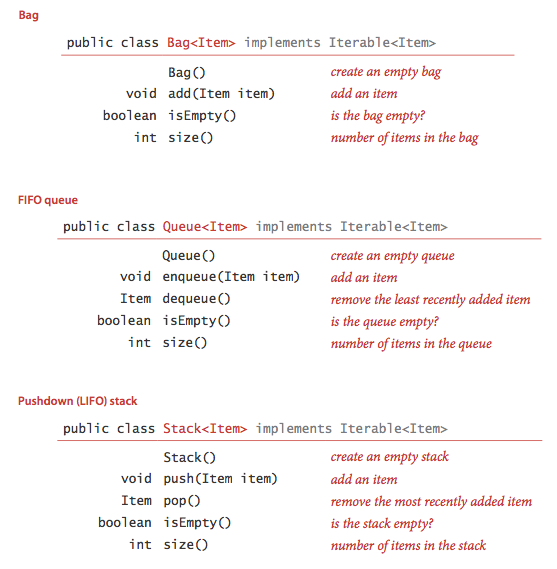
- Generics. An essential characteristic of collection ADTs is that we should be able to use them for any type of data. A specific Java mechanism known as generics enables this capability. The notation <Item> after the class name in each of our APIs defines the name Item as a type parameter, a symbolic placeholder for some concrete type to be used by the client. You can read Stack<Item> as "stack of items." For example, you can write code such as
to use a stack for String objects.Stack<String> stack = new Stack<String>();
stack.push("Test");
...
String next = stack.pop(); - Autoboxing. Type parameters have to be instantiated as reference types, so Java automatically converts between a primitive type and its corresponding wrapper type in assignments, method arguments, and arithmetic/logic expressions. This conversion enables us to use generics with primitive types, as in the following code:
Automatically casting a primitive type to a wrapper type is known as autoboxing, and automatically casting a wrapper type to a primitive type is known as auto-unboxing.Stack<Integer> stack = new Stack<Integer>(); stack.push(17);
// auto-boxing (int -> Integer) int i = stack.pop();
// auto-unboxing (Integer -> int) - Iterable collections. For many applications, the client's requirement is just to process each of the items in some way, or to iterate through the items in the collection. Java's foreach statement supports this paradigm. For example, suppose that collection is a Queue<Transaction>. Then, if the collection is iterable, the client can print a transaction list with a single statement:
for (Transaction t : collection)
StdOut.println(t); - Bags. A bag is a collection where removing items is not supported—its purpose is to provide clients with the ability to collect items and then to iterate through the collected items. Stats.java is a bag client that reads a sequence of real numbers from standard input and prints out their mean and standard deviation.
- FIFO queues. A FIFO queue is a collection that is based on the first-in-first-out (FIFO) policy. The policy of doing tasks in the same order that they arrive server is one that we encounter frequently in everyday life: from people waiting in line at a theater, to cars waiting in line at a toll booth, to tasks waiting to be serviced by an application on your computer.
- Pushdown stack. A pushdown stack is a collection that is based on the last-in-first-out (LIFO) policy. When you click a hyperlink, your browser displays the new page (and pushes onto a stack). You can keep clicking on hyperlinks to visit new pages, but you can always revisit the previous page by clicking the back button (popping it from the stack). Reverse.java is a stack client that reads a sequence of integers from standard input and prints them in reverse order.
- Arithmetic expression evaluation. Evaluate.java is a stack client that evaluates fully parenthesized arithmetic expressions. It uses Dijkstra's 2-stack algorithm:
- Push operands onto the operand stack.
- Push operators onto the operator stack.
- Ignore left parentheses.
- On encountering a right parenthesis, pop an operator, pop the requisite number of operands, and push onto the operand stack the result of applying that operator to those operands.
This code is a simple example of an interpreter.
Array and resizing array implementations of collections.
- Fixed-capacity stack of strings. FixedCapacityStackOfString.java implements a fixed-capacity stack of strings using an array.
- Fixed-capacity generic stack. FixedCapacityStack.java implements a generic fixed-capacity stack.
- Array resizing stack. ResizingArrayStack.java implements a generic stack using a resizing array. With a resizing array, we dynamically adjust the size of the array so that it is both sufficiently large to hold all of the items and not so large as to waste an excessive amount of space. Wedouble the size of the array in push() if it is full; we halve the size of the array in pop() if it is less than one-quarter full.
- Array resizing queue. ResizingArrayQueue.java implements the queue API with a resizing array.
Linked lists.
A linked list is a recursive data structure that is either empty (null) or a reference to a node having a generic item and a reference to a linked list. To implement a linked list, we start with a nested class that defines the node abstraction
private class Node {
Item item;
Node next;
}
- Building a linked list. To build a linked list that contains the items to, be, and or, we create a Node for each item, set the item field in each of th
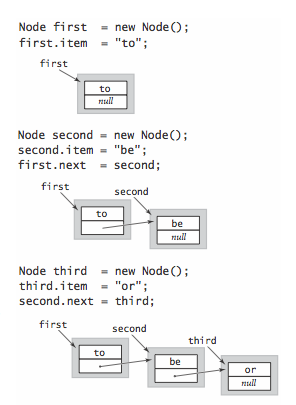
- Insert at the beginning. The easiest place to insert a new node in a linked list is at the beginning.
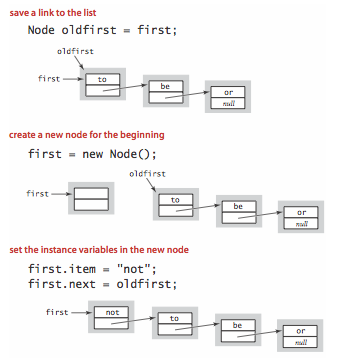
- Remove from the beginning. Removing the first node in a linked list is also easy.
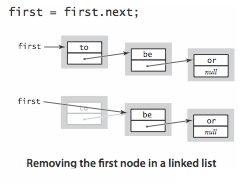
- Insert at the end. To insert a node at the end of a linked list, we maintain a link to the last node in the list.
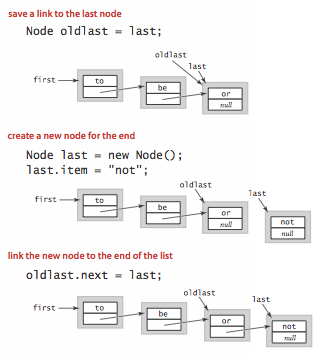
- Traversal. The following is the idiom for traversing the nodes in a linked list.
for (Node x = first; x != null; x = x.next) {
// process x.item
}
Linked-list implementations of collections.
- Linked list implementation of a stack. Stack.java implements a generic stack using a linked list. It maintains the stack as a linked list, with the top of the stack at the beginning, referenced by an instance variable first. To push() an item, we add it to the beginning of the list; to pop()an item, we remove it from the beginning of the list.
- Linked list implementation of a queue. Program Queue.java implements a generic FIFO queue using a linked list. It maintains the queue as a linked list in order from least recently to most recently added items, with the beginning of the queue referenced by an instance variable firstand the end of the queue referenced by an instance variable last. To enqueue() an item, we add it to the end of the list; to dequeue() an item, we remove it from the beginning of the list.
- Linked list implementation of a bag. Program Bag.java implements a generic bag using a linked list. The implementation is the same as Stack.javaexcept for changing the name of push() to add() and removing pop().
Iteration.
To consider the task of implementing iteration, we start with a snippet of client code that prints all of the items in a collection of strings, one per line:This foreach statement is shorthand for the following while statement:
...
for (String s : collection)
StdOut.println(s);
...
To implement iteration in a collection:
while (i.hasNext()) {
String s = i.next();
StdOut.println(s);
}
- Include the following import statement so that our code can refer to Java's java.util.Iterator interface:
import java.util.Iterator;
- Add the following to the class declaration, a promise to provide an iterator() method, as specified in the java.lang.Iterable interface:
implements Iterable<Item>
- Implement a method iterator() that returns an object from a class that implements the Iterator interface:
public Iterator<Item> iterator() {
return new ListIterator();
} - Implement a nested class that implements the Iterator interface by including the methods hasNext(), next(), and remove(). We always use an empty method for the optional remove() method because interleaving iteration with operations that modify the data structure is best avoided.
- The nested class ListIterator in Bag.java illustrates how to implement a class that implements the Iterator interface when the underlying data structure is a linked list.
- The nested class ArrayIterator in ArrayResizingBag.java does the same when the underlying data structure is an array.
Autoboxing Q + A
Q. How does auto-boxing handle the following code fragment?
A. It results in a run-time error. Primitive type can store every value of their corresponding wrapper type except null.
Q. Why does the first group of statements print true, but the second false?
Integer a2 = 100;
System.out.println(a1 == a2);
// true Integer b1 = new Integer(100);
Integer b2 = new Integer(100);
System.out.println(b1 == b2);
// false Integer c1 = 150;
Integer c2 = 150;
System.out.println(c1 == c2);
// false
A. The second prints false because b1 and b2 are references to different Integer objects. The first and third code fragments rely on autoboxing. Surprisingly the first prints true because values between -128 and 127 appear to refer to the same immutable Integer objects (Java's implementation of valueOf() retrieves a cached values if the integer is between -128 and 127), while Java constructs new objects for each integer outside this range.
Here is another Autoboxing.java anomaly.
Generics Q + A
Q. Are generics solely for auto-casting?
A. No, but we will use them only for "concrete parameterized types", where each data type is parameterized by a single type. The primary benefit is to discover type mismatch errors at compile-time instead of run-time. There are other more general (and more complicated) uses of generics, including wildcards. This generality is useful for handling subtypes and inheritance. For more information, see this Generics FAQ and this generics tutorial.
Q. Can concrete parameterized types be used in the same way as normal types?
A. Yes, with a few exceptions (array creation, exception handling, with instanceof, and in a class literal).
Q. Why do I get a "can't create an array of generics" error when I try to create an array of generics?
public class ResizingArrayStack<Item> {
Item[] a = new Item[1];
}
A. Unfortunately, creating arrays of generics is not possible in Java 1.5. The underlying cause is that arrays in Java are covariant, but generics are not. In other words, String[] is a subtype of Object[], but Stack<String> is not a subtype of Stack<Object>. To get around this defect, you need to perform an unchecked cast as in ResizingArrayStack.java.
Q. So, why are arrays covariant?
A. Many programmers (and programming language theorists) consider covariant arrays to be a serious defect in Java's type system: they incur unnecessary run-time performance overhead (for example, see ArrayStoreException) and can lead to subtle bugs. Covariant arrays were introduced in Java to circumvent the problem that Java didn't originally include generics in its design, e.g., to implement Arrays.sort(Comparable[]) and have it be callable with an input array of type String[].
Q. Can I create and return a new array of a parameterized type, e.g., to implement a toArray() method for a generic queue?
A. Not easily. You can do it using reflection provided that the client passes an object of the desired concrete type to toArray() This is the (awkward) approach taken by Java's Collection Framework.
public static int BUFFERSIZE = 2048;
public BufferedReader fbr;
public File originalfile;
private String cache;
private boolean empty;
public BinaryFileBuffer(File f, Charset cs) throws IOException {
originalfile = f;
fbr = new BufferedReader(new InputStreamReader(new FileInputStream(f), cs), BUFFERSIZE);
reload();
}
public boolean empty() {
return empty;
}
private void reload() throws IOException {
try {
if ((this.cache = fbr.readLine()) == null) {
empty = true;
cache = null;
} else {
empty = false;
}
} catch (EOFException oef) {
empty = true;
cache = null;
}
}
public void close() throws IOException {
fbr.close();
}
public String peek() {
if (empty())
return null;
return cache.toString();
}
public String pop() throws IOException {
String answer = peek();
reload();
return answer;
}
}


